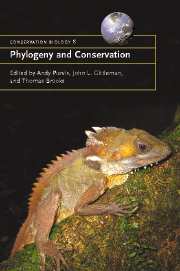Crossref Citations
This Book has been
cited by the following publications. This list is generated based on data provided by Crossref.
2006.
List of books for review.
Environmental and Ecological Statistics,
Vol. 13,
Issue. 4,
p.
465.
Spathelf, Miles
and
Waite, T. A.
2007.
Will hotspots conserve extra primate and carnivore evolutionary history?.
Diversity and Distributions,
Vol. 13,
Issue. 6,
p.
746.
Johnson, J. A.
Thorstrom, R.
and
Mindell, D. P.
2007.
Systematics and conservation of the hook‐billed kite including the island taxa from Cuba and Grenada.
Animal Conservation,
Vol. 10,
Issue. 3,
p.
349.
de Carvalho, Marcelo R.
Bockmann, Flávio A.
Amorim, Dalton S.
Brandão, Carlos Roberto F.
de Vivo, Mário
de Figueiredo, José L.
Britski, Heraldo A.
de Pinna, Mário C. C.
Menezes, Naércio A.
Marques, Fernando P. L.
Papavero, Nelson
Cancello, Eliana M.
Crisci, Jorge V.
McEachran, John D.
Schelly, Robert C.
Lundberg, John G.
Gill, Anthony C.
Britz, Ralf
Wheeler, Quentin D.
Stiassny, Melanie L. J.
Parenti, Lynne R.
Page, Larry M.
Wheeler, Ward C.
Faivovich, Julián
Vari, Richard P.
Grande, Lance
Humphries, Chris J.
DeSalle, Rob
Ebach, Malte C.
and
Nelson, Gareth J.
2007.
Taxonomic Impediment or Impediment to Taxonomy? A Commentary on Systematics and the Cybertaxonomic-Automation Paradigm.
Evolutionary Biology,
Vol. 34,
Issue. 3-4,
p.
140.
Jablonski, David
2008.
Species Selection: Theory and Data.
Annual Review of Ecology, Evolution, and Systematics,
Vol. 39,
Issue. 1,
p.
501.
de Carvalho, Marcelo R.
Bockmann, Flávio A.
Amorim, Dalton S.
and
Brandão, Carlos Roberto F.
2008.
Systematics must Embrace Comparative Biology and Evolution, not Speed and Automation.
Evolutionary Biology,
Vol. 35,
Issue. 2,
p.
150.
Johnson, Jeff A.
2008.
Recent Range Expansion and Divergence among North American Prairie Grouse.
Journal of Heredity,
Vol. 99,
Issue. 2,
p.
165.
Galloway, David J.
2008.
Austral lichenology: 1690–2008.
New Zealand Journal of Botany,
Vol. 46,
Issue. 4,
p.
433.
Pyenson, Nicholas D.
2009.
Requiem for Lipotes: An evolutionary perspective on marine mammal extinction.
Marine Mammal Science,
Vol. 25,
Issue. 3,
p.
714.
ROSAUER, DAN
LAFFAN, SHAWN W.
CRISP, MICHAEL D.
DONNELLAN, STEPHEN C.
and
COOK, LYN G.
2009.
Phylogenetic endemism: a new approach for identifying geographical concentrations of evolutionary history.
Molecular Ecology,
Vol. 18,
Issue. 19,
p.
4061.
Minh, B.Q.
Pardi, F.
Klaere, S.
and
von Haeseler, A.
2009.
Budgeted Phylogenetic Diversity on Circular Split Systems.
IEEE/ACM Transactions on Computational Biology and Bioinformatics,
Vol. 6,
Issue. 1,
p.
22.
Price, Samantha A.
and
Bininda-Emonds, Olaf R. P.
2009.
A comprehensive phylogeny of extant horses, rhinos and tapirs (Perissodactyla) through data combination.
Zoosystematics and Evolution,
Vol. 85,
Issue. 2,
p.
277.
Cadotte, Marc W.
and
Jonathan Davies, T.
2010.
Rarest of the rare: advances in combining evolutionary distinctiveness and scarcity to inform conservation at biogeographical scales.
Diversity and Distributions,
Vol. 16,
Issue. 3,
p.
376.
Lamoreux, John F.
and
Lacher, Thomas E.
2010.
Mammalian endemism, range size and conservation status in the southern temperate zone.
Diversity and Distributions,
Vol. 16,
Issue. 6,
p.
922.
Cameron, Kenneth M.
2010.
On the Value of Taxonomy, Phylogeny, and Systematics to Orchid Conservation: Implications for China’s Yachang Orchid Reserve.
The Botanical Review,
Vol. 76,
Issue. 2,
p.
165.
Avise, John C.
2010.
Perspective: conservation genetics enters the genomics era.
Conservation Genetics,
Vol. 11,
Issue. 2,
p.
665.
Bielby, J.
Cardillo, M.
Cooper, N.
and
Purvis, A.
2010.
Modelling extinction risk in multispecies data sets: phylogenetically independent contrasts versus decision trees.
Biodiversity and Conservation,
Vol. 19,
Issue. 1,
p.
113.
AVISE, JOHN C.
and
LIU, JIN-XIAN
2011.
On the temporal inconsistencies of Linnean taxonomic ranks.
Biological Journal of the Linnean Society,
Vol. 102,
Issue. 4,
p.
707.
Morlon, Hélène
Schwilk, Dylan W.
Bryant, Jessica A.
Marquet, Pablo A.
Rebelo, Anthony G.
Tauss, Catherine
Bohannan, Brendan J. M.
and
Green, Jessica L.
2011.
Spatial patterns of phylogenetic diversity.
Ecology Letters,
Vol. 14,
Issue. 2,
p.
141.
Rolland, Jonathan
Cadotte, Marc W.
Davies, Jonathan
Devictor, Vincent
Lavergne, Sebastien
Mouquet, Nicolas
Pavoine, Sandrine
Rodrigues, Ana
Thuiller, Wilfried
Turcati, Laure
Winter, Marten
Zupan, Laure
Jabot, Franck
and
Morlon, Hélène
2012.
Using phylogenies in conservation: new perspectives.
Biology Letters,
Vol. 8,
Issue. 5,
p.
692.



